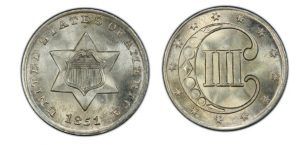Three Reasons the U.S. Mint Produced This Odd Denomination
Posted onThree-cent pieces were first produced in silver in 1851 to help smooth the simple act of buying a postage stamp, which cost three cents at the time. The odd denomination was also seen as a solution for merchants to easily make change for some of the foreign coins that were still legal tender in our country.
also seen as a solution for merchants to easily make change for some of the foreign coins that were still legal tender in our country.
Then, the Civil war broke out. The war impacted nearly every aspect of American life during its tumultuous years, including the economy. To protect against the economic turmoil that the war created, Americans of means began hoarding silver coins – including these silver three-cent pieces.
After the war ended, silver coin hoarding continued. The simple act of making change, or purchasing those three-cent stamps proved challenging.
To combat these problems, Congress passed legislation in 1865 that authorized the production of three-cent pieces comprised of 75% copper and 25% nickel.
James B. Longacre, the Chief Engraver of the U.S. Mint, designed the new Nickel Three-Cent piece to mimic the look and appearance of a silver coin. The Nickel Three-Cent piece featured a color that was more white than brown. Longacre also chose to enlarge the size of the Nickel Three-Cent piece over the existing three-cent silver coin (there had been complaints the silver coin was too small).
Nickel Three-Cent pieces were minted from 1865-1889 at the Philadelphia Mint. Over 30 million Nickel Three-Cent pieces were produced in that 24 year period. After 1889, the Treasury melted down millions of them to create the new five-cent Liberty Head Nickels.
Collectors today remain intrigued by this odd denomination coin – especially around the years in which only proofs were struck: 1877, 1878, and 1886. Other dates including 1883, 1884 and 1885 are represented by tiny mintages of 4,000, 1,700 and 1,000 respectively.
Given the Treasury’s melting campaign and limited mintages of some years, these odd Nickel Three-Cent pieces create unique opportunities for collectors who aspire to own coins from the post-Civil war period in our country.
Want to read more? Subscribe to the Blanchard Newsletter and get our tales from the vault, our favorite stories from around the world and the latest tangible assets news delivered to your inbox weekly.







